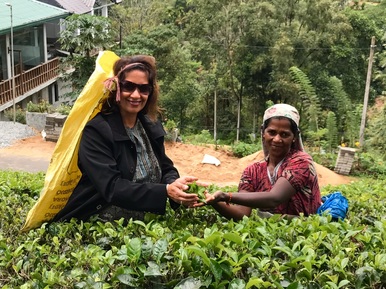Road Trip to Madukele
Glenloch Tea Factory
The type of tea is based on which part of the tea leaves are used in the production process. White tea, famous in Sri Lanka, uses only the silver tips of the tea leaf and the leaves are sun dried with no processing at all, which makes this the most expensive tea. Next is green tea which is steamed, dried and then rolled. Although most of us consider green tea to be the best for us, black tea actually has higher antioxidants. Because black tea is the most common, this is the least expensive. The grade or quality of the tea ranges from Pekoe, Broken Orange Pekoe (BOP), Broken Orange Pekoe Fine (BOPF), and Dust. The higher quality teas such as Pekoe and BOP, are meant to be had plain without any milk or sugar to dilute the richness of the flavor. The lower grades such as BOPF and Dust are meant to be consumed with milk and sugar. The flavored teas such as masala chai, vanilla and strawberry teas are created by adding various flavors to the BOP variety. The taste itself is actually determined mainly by the weather, elevation, and soil conditions of the region in which the tea is grown. The workers are predominantly Hindu whereas the owners are of Muslim descent.
After an in depth tour of the factory, we enjoyed a cup of tea while overlooking a magnificent view of the mountains. We were even able to join the workers on the hill and help them pick a few leaves ourselves.
Temple of the Sacred Tooth Relic
When Buddha passed and was cremated, four of his teeth along with his frontal lobe, jaw bone, and collar bone were retrieved from the ashes. Of the four teeth, one was said to be lost in the Northwest part of the country, one is in a stupa in the jungles of Sri Lanka, one was taken to the heavenly realm and the last tooth is housed in a Russian Doll series of casings (seven in all) in the Temple of the Sacred Tooth in Kandy. This very special stupa is made of gold and adorned by jewels. It is secured in a room behind the worship area on the second floor, that is bullet proof and inaccessible to the general public. This temple is considered a Maligawa, or palace, and the tooth is worshiped as if it were Buddha himself.
Once a year, there is a large procession in which a relic of the tooth (not the actual tooth that is secured in the temple) is placed in a stupa and paraded around Kandy. Nearly 100 elephants are adorned with festive attire and the lead elephant is charged with carrying this relic in an ornate silver canopy. Leading the procession are a group of drummers and dancers. With lights and music and tremendous fanfare, this festival is a sight to see.
The actual tooth is only brought out once every five to seven years. However, the past ten years there has been no exhibition of this tooth because the weather doesn't allow for it. It is believed that whenever the sacred tooth is displayed, the city receives some form of rainfall. When it is exhibited, the lines to see this holy relic run well outside the temple and into the city. Residents camp out for days to get a glimpse.
I can understand why this temple is so sacred. Not only is Buddha's tooth, and in the people's mind Buddha himself, housed within its walls, there is an incredible spiritual energy here.


 RSS Feed
RSS Feed